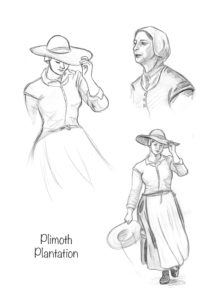Sarah Knittle
Artist and IllustratorPlimoth Plantation Visit
Got to drive out to Plimoth Plantation. Beautiful area and dedication to its history. I took my sketchbook and my camera to take notes, reference photos for the era and draw the people and animals present. It’s a great fun place to visit and learn, and an under utilized opportunity for life drawing.
Here are some pencil sketches that I cleaned up a bit in the computer.
I have yet for find a way to draw a chicken that doesn’t make it look at least slightly evil and murderous.
I had a lot of fun drawing the actors there. I have plenty of sketches that I haven’t uploaded yet, but I would like to turn them into watercolors, including one of a man who taught me a lot about pistols of the era, talking to him helped fill out the information I was missing from the Pirate Museum.
Visited the New Whydah Pirate Museum
One question from my childhood I always remember being frequently asked was the age old, “Pirates or Ninjas?” For a long time I answered with ninjas, because it seemed so obvious, who could beat a stealthy and highly trained ancient assassin? Certainly a brash and drunken pirate would stand no chance. But as my historic interests expanded I came to appreciate and view those seafaring brigands in a whole new light.
I took a trip to the new Whydah Pirate Museum in West Yarmouth recently. From my perspective the Whydah Gally ought to have more recognition in the world, and she carries a more thrilling and romantic tale than Blackbeard and his ship. Captained by “Black Sam” Bellamy, the very “Prince of Pirates” who left his home in England and sailed to Cape Cod in 1715.
The story is a popular one here on Cape and I often heard it as a kid. As the story goes he met a beautiful girl in Wellfleet named Maria Hallet and fell in love, but his impoverished state made him an unworthy suitor in the eyes of her family. So Samuel embarked on a ship to seek treasure from wrecked Spanish ships off the Floridian coast. But there was little to find, and the crew turned to becoming privateers under the famous Benjamin Hornigold and his second Edward Teach, when privateering became outlawed they continued and became the pirates we now know them as.
Sam and his crew mutinied when Hornigold refused to attack English ships. They went on capturing merchant ships, taking a veritable fleet for their own. He earned the nickname of “Black Sam” for his natural black hair. White powdered wigs were still the fashion of the elite at time and Bellamy had been a poor man his whole life, and despite the great amount of wealth he acquired, he didn’t change who he was on the outside, a choice that speaks to his reputation as a sort of Robin Hood of the sea.
In 1717 Bellamy captured the Whydah Gally, a state of the art slave ship, she was fast, easily maneuvered, and armed. Laden with wealth he finally made his way back to Cape Cod, the stories say he was coming for Maria Hallet, he planned to return a wealthy man, worthy of her and sail them to a new life. Though as he approached, a storm brewed, and then it raged. He never made it ashore, Bellamy, his crew, and all the wealth he planned to start his new life with, sank to the bottom of the ocean, where they stayed until their discovery.
To add to the tragedy Maria Hallet was supposedly pregnant with Bellamy’s child just before he left, she lost the baby under mysterious circumstances and died herself after being cast out from the town. I remember hearing that her ghost still haunts the dunes, waiting for Bellamy to come back for her.
The history and legend tends to mix but it’s still my favorite bit of local lore. It’s tragic, romantic and I couldn’t resist going to the museum to see and sketch the recovered artifacts.
Having been covered up by thirty feet of sand the wreck has been impressively preserved. To date it is the only pirate treasure ever recovered.
Artifacts I found particularly fascinating were the grenades, and learning about the kinds of weapons available to pirates. Heavy iron spheres, hollowed yet with a thick shell, they were about the size of my closed fist, just larger than a baseball. They had large stoppers plugging them, appearing to be made of wood and their texture was rough, not smooth or polished, possibly due to their time in the sea, but most likely that was their original texture.
The exhibit also sparked an interest in historic fire-arms, I had always given my attention to more ancient weapons such as swords, war-hammers, bows, pole-arms, etc. The recovered pistol and musket pieces were absolutely beautiful though.
The metal detailing and decorations that were on their pistols (though the actual guns did not quite survive) were ornate and elegant. There was much care put into their maintenance and the crew valued quality and workmanship in their weapons.
There were many other items, recovered shoes, a silken sock, silk ribbon, buttons, clothing hooks, dinnerware, and of course the massive store of coins, with more still being found in the concretions.
Below I included some sketches I made at the museum of dragon plates that were recovered, the originals were broken in places but they all seemed to be accounted for and I connected them into a whole piece in my sketches. Then a pencil/digital sketch of what I think a pistol may have looked like with the decoration.

I hope to add more of my sketches from the museum soon, also sketches from my visit to Plimouth Plantation.


